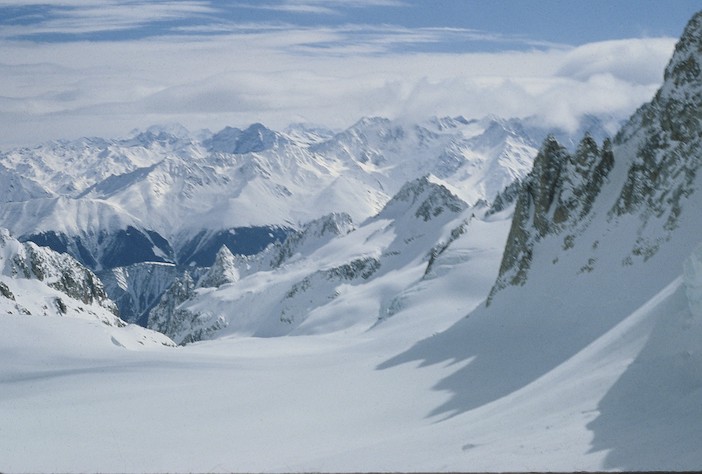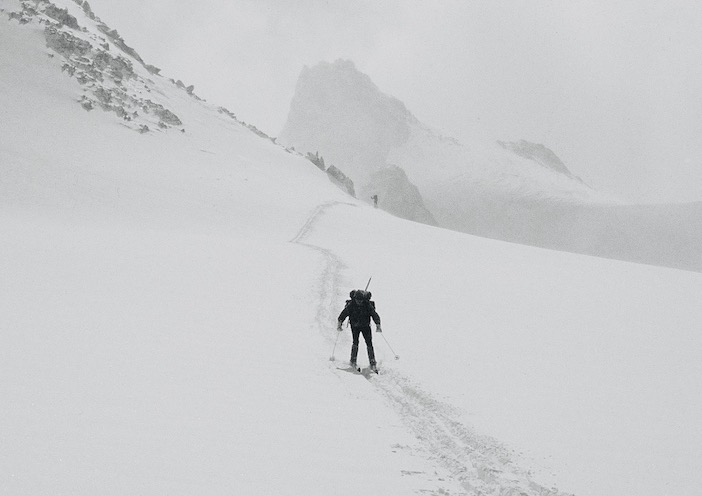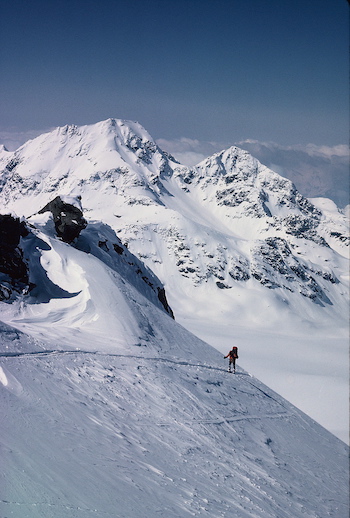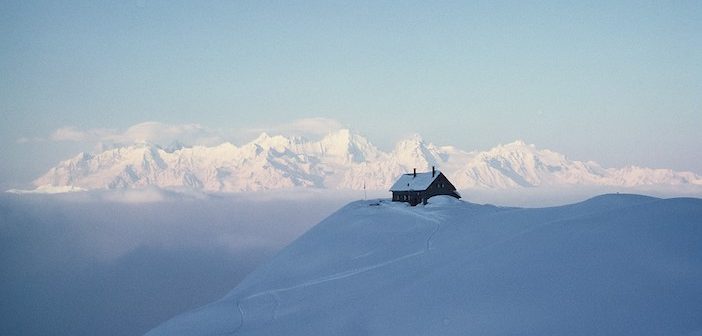In the second part of our travel feature this festive season, ex-army major Philip Cottam negotiates the Haute Route, the Alps’ most challenging ski-mountaineering challenge…
We were doing the route early in the season and it was not much more than a week since there had been a heavy fall of snow. As a result we could not see any signs of the slab but we could certainly hear it. We knew there was likely to be wind slab at some point during the trip and had planned our route to avoid open lee slopes whenever possible. Areas with crosswinds are more difficult to identify. We had unexpectedly bumped into a wind slab that must have been caused by a cross wind. I have ascended or descended this slope several times when traversing the Col du Chardonnet and this was the only time I ever came across wind slab. We were just unlucky.

View from the Col du Chardonnet
The first thing we did was take our skis off to reduce vibration and traverse left until we were under the ice fall of the glacier for some protection if the slab broke. The four of us then had a brief chat to decide what to do. Retreat was going to be as risky as continuing so we decided to carry on upwards. We re-checked that our avalanche transceivers were all switched on and then began to move one at a time carrying our skis until we were out of the danger zone.
My job as tail end Charlie at this stage was to watch Zak, Chris and Phil by turns in case one of them was swept away and we had to do a rapid rescue. They then watched me when it was my turn. The four or five hundred yards involved seemed to take for ever as, without our skis, we sank knee deep into the snow. Zak, still the trail breaker (he had lost the toss) and uncomplaining as ever, had the hardest job. At least the rest of us had a trench we could struggle up.

Emerging out of low cloud onto the Plateau du Trient
With our skis back on and the surface of the glacier now almost level we made rapid progress to the col. Given the amount of snow we had encountered far we suspected we would be able to ski down the other side and we were right. Later in the season or with less snowfall it often becomes icy and has to be abseiled down or climbed down using crampons, both of which take more time than just skiing down. Having descended the col we then skied easily round the corner to the foot of the next col – the Fenêtre de Saleina. Crossing this involves a steep but thankfully short ascent that leads to the massive open space of the beautiful Plateau du Trient. Once on the Plateau there was a gentle ski to the Cabane du Trient with the granite ridge of the appropriately named Aiguilles Dorées glistening in the early afternoon sunshine.
Meeting the Swiss Army
After the travails of the morning it was good to reach the shelter of the Trient Hut. It was smaller then than it is now. There was also no guardian service as it was too early in the season and explains why we were carrying so much food. However, the winter room had a good stove and there was lots of firewood. It was not long before we were having a brew, drying anything that needed drying and starting to think about what we would add to our spaghetti – not that there was much choice. As the sun set we sat outside to watch the shadows lengthen over the plateau and its surrounding peaks. Darkness fell all too quickly along with the temperature. All that was missing from the clear night sky was a full moon to make it picture prefect. Back inside the hut we banked down the fire and curled up in our sleeping bags.

Climbing to the Col des Écandie in deep snow
We woke up with a mug of tea provided by Phil to find ourselves deep in cloud and with near white out conditions. The plan had been to cross the ridge behind the hut by abseiling down the Fenêtre des Chamois. Given the conditions we decided instead to cross over the ridge via the Col des Ecandies. This involved a short ski down the right bank of the Trient glacier before we had to remove our skis and scramble up the steepish snow and rock leading to the col. Sadly, instead of what should have been a wonderful view of the Val d’Arpette and an equally wonderful ski, we were met with even less visibility. Our skiing at this point can only be described as slow and clumsy especially for the lead skier, myself on this occasion, as we struggled with the lack of visibility.
Once the start of the tree line began to emerge below us everything speeded up and the skiing became less clumsy and more enjoyable. At least it did until we spotted some shooting targets and armed men in uniform in the distance. We promptly hit the deck. It seemed we were skiing into the danger area of a temporary Swiss Army rifle range. A quick look through my binoculars showed that, thankfully, they were still setting up the targets. We skied down towards them as quickly as we could. They were as surprised as we were. Given the conditions, they had not expected anyone to be skiing in the Val d’Arpette that day and the white out had hidden their range warning flags. After sharing mugs of Swiss Army coffee, reinforced with something much stronger, we continued on our way until we were able to sink a much-needed beer at the Relais d’Arpette before skiing down the gentle snow-covered track that leads into the village of Champex.
Plans Disrupted
Our original plan had been to get transport from Champex to Bourg St Pierre and head up to the Valsorey Hut, traverse the upper slopes of the Grand Combin on the way to the Chanrion Hut before then skiing to the Vignettes Hut. This is the classic route. Because of the uncertain weather and the increased avalanche risk resulting from the heavy snow conditions we decided to go via Verbier to the Cabane de Dix and traverse over the Pigne d’Arolla to the Vignettes Hut where the two routes join up. Although still demanding we were less likely to be forced to turn back taking this option and it also tends to be less avalanche prone although the traverse along the west bank of the Lac des Dix requires care.

Ascending Rosablanche on the way to the Dix Hut
Conditions were no better when we got to Verbier. If anything, visibility had become worse. Getting to the Montfort Hut (main picture) was not going to be straightforward. There are many more lifts now and you can get to the hut by lift almost all the way. We got to the top of what was then the main lift which was still a significant distance from the hut. With visibility down to less than 10 yards we could easily have trudged past the hut and never seen it. Rather than indulge in what could have become an unnecessary drama we decided to head back down to the lift middle station and bivouac.
We then had an unexpected piece of luck. One of the lift workers recognised me from a couple of years before when, by chance, we had both been staying in the same mountain hut. He promptly marched us into their canteen, broke open some cans of beer, let us use their kitchen to cook our evening meal and opened a storeroom where we could sleep. He even woke us up early the next morning with hot water for our coffee. An early morning it was too as we needed to make up for the time we had lost by not getting to the Monfort Hut.
We had decided we were going to ski to the Dix Hut in one day, rather than the two of normal practice, by not breaking the journey at the Prafleuri Hut. Starting as we were from near Les Ruinettes, about an hour or more of skiing below the Montfort Hut, we had not far short of 30 kilometres of skiing ahead of us. Parties can sometimes take as long as 6 hours to ski from the Montfort Hut via Rosablanche to the Prafleuri Hut and a up to a further 6 hours from the Prafleuri Hut to the Dix Hut. To our joy the sky was clear and there was little wind. We might have a long day ahead but at least the weather was on our side. Getting to the Dix Hut in one day was definitely on.
Philip’s adventure across the Haute Route concludes next weekend as he and his team mates experience the hardest stage…
Photographs by Philip Cottam and courtesy of International Alpine Guides who run tours of the Haute Route. For more information, please visit www.internationalalpineguides.com.




